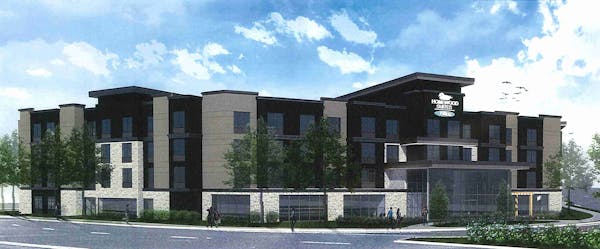The period between the late 1930s and early 1960s might well be called the Face-Lift Era in American architecture.
During this time, thousands of old buildings, most commonly retail stores, were sheathed in new facades to make them appear more up-to-date.
Sometimes this full frontal surgery produced elegant results, in other cases, the finished products were atrocious. Most of these facade jobs are now gone, along with the buildings they once purported to enhance, but their history offers a fascinating glimpse into an architectural age obsessed with modernism.
In Minnesota, the most prominent face-lifts occurred in downtown Minneapolis and St. Paul, where department stores in particular sought to convey a fresh new image. So did at least one major downtown Minneapolis hotel, the Radisson, which traded in its fine old Beaux Arts facade for a simplified modern look in 1961. (A new Radisson was built downtown in 1987.)
Before the Face-Lift Era, exterior remodeling of commercial buildings typically was limited to ground-floor shop fronts, except in special cases. In downtown St. Paul, for example, scores of new building fronts were installed along the west side of Robert Street in 1913 as part of a massive street-widening project.
But it wasn't until the 1930s, with the arrival of the sleek Moderne style, that business owners began to invest in complete face-lifts as a way to create an up-to-the-minute look.
In downtown Minneapolis, one of the first big face jobs occurred around 1940, when the Davis and Ruben Furniture Co. put a slick Moderne-style front on its old four-story building at 87 S. 7th St., where the IDS Center now stands.
Eight years later, a much larger face-lift transformed the iconic Donaldsons department store on Nicollet Avenue between 6th and 7th streets.
Like many other large downtown department stores, by the late 1940s Donaldsons was something of a visual mishmash, occupying all or parts of four buildings in different styles.
To bring these disparate elements together, the Minneapolis architectural firm of Larson and McLaren wrapped the lower two floors in a band of smooth, light-colored stone. However, the original five-story portion of the store at 6th Street, built in 1888 and known as the "Glass Block" because of its many windows, received an entirely new facade featuring long ribbon windows of glass block on the upper floors and sleek Moderne detailing.
Whether all of this work improved the store's appearance is open to debate, but the new facade certainly signaled to shoppers that Donaldsons wasn't stuck in its Victorian past. (It was destroyed by fire in 1982.)
Donaldsons' neighbor on Nicollet, the J.C. Penney department store (which was razed in 1989) between 5th and 6th streets, underwent a far less appealing transformation, also by Larson and McLaren, in 1959. The store, which occupied the historic 1883 Syndicate Block, was encased in a largely windowless new facade consisting of beige metal panels. The result cannot be described as fetching.
Another large face-lift in downtown Minneapolis involved the LaSalle Building at 7th Street and Marquette Avenue S. Opened in 1917, the eight-story LaSalle (later known as the Marquette Bank Building) originally featured rather fussy, classically inspired facades.
These were stripped away in 1949, with Larson and McLaren again doing the work, and replaced by a much simpler look that included new stonework surrounding the building's windows. Alas, the new facades couldn't save the building, which was demolished in 1970.
The good, the ugly in St. Paul
Because of its long history of street-widening, downtown St. Paul probably saw more building face-lifts than anywhere else in the state.
One of the best still stands: a four-story building at 139 E. 7th St. that is now home to Alary's Bar.
The Elvgren Paint Co., which once occupied the building, hired the St. Paul architectural firm of Toltz, King and Day to design a new Art Deco facade after the original front was removed as part of a street-widening project in 1930. Executed in glass, stone and metal, the facade is one of the loveliest — new or old — in downtown St. Paul.
Unfortunately, St. Paul was also the scene of perhaps the worst facade job of the era in 1959. That would be the historic Emporium department store (now the Metro Square Building) at 7th and Robert streets, which was swathed in a corrugated metal veneer so hideous that it must have caused weeping in the streets.
It's not known if any architects were involved in this desecration, but if there were, may God have mercy on their souls. The Emporium's metal skin came to be so widely despised that it was removed in 1987, on purely aesthetic grounds, and replaced by an unremarkable but relatively inoffensive front face of blue glass.
It's unlikely there will ever be a repeat of the Face-Lift Era in Minneapolis or St. Paul, mainly because most downtown buildings today are so monolithic that the cost of new facades would be prohibitive.
Maybe that's a good thing, although I can think of quite a few recent downtown buildings, which tend toward the dull and formulaic, that might benefit from a little cosmetic surgery.
Larry Millett is an architecture critic and author of 14 nonfiction books and eight mystery novels. He can be reached at larrymillett.com.
Complex stories of migration are among the finalists for the Women's Prize for Fiction
Olympian Kristi Yamaguchi is 'tickled pink' to inspire a Barbie doll

After 4 decades in music and major vocal surgery, Jon Bon Jovi is optimistic and still rocking
Rom-com author Emily Henry knows the secret to having a healthy relationship with love

